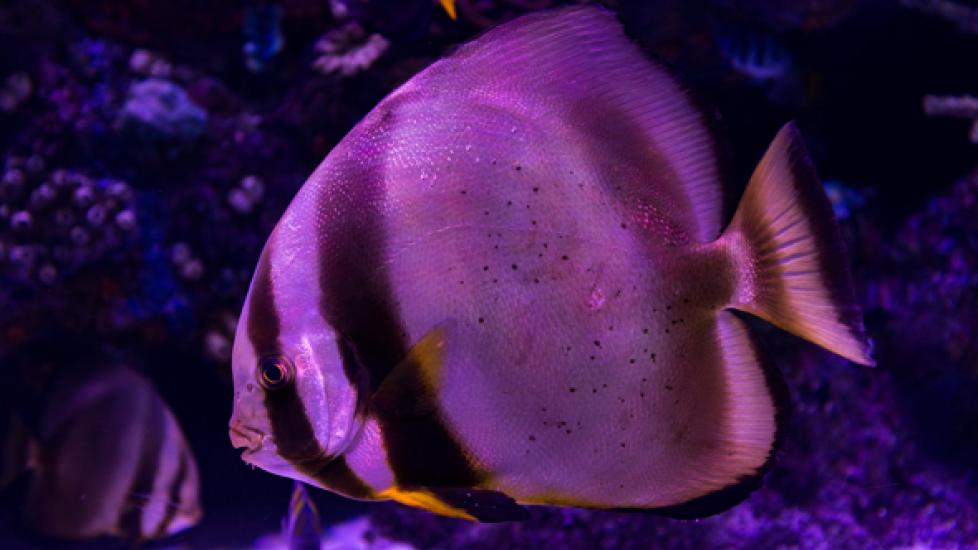Should I Add Moonlight to My Reef Tank?
Image via iStock.com/greenp
By Kenneth Wingerter
Lighting is one of the most important components in a saltwater fish aquarium system. This is particularly so if you keep photosynthetic organisms such as corals, macroalgae and tridacnid clams. The most effective marine aquarium lighting system is the one that is most controlled.
Reef Tank Lighting Schedule
One of the major lighting parameters that is most commonly controlled is photoperiod. Put most simply, in the context of an artificial environment, photoperiod is the tank's lighting schedule. Aquarium photoperiod is controlled by timers (ranging from cheap household plug-in units to highly capable hardware/software located either in the unit or in "the cloud").
Generally, timers are set to operate the lighting at its highest intensity during midday when ambient light (light pollution from the room) is strongest. With your aquarium lights timed to match the ambient photoperiod, strong light pollution won't inhibit the normal nighttime activities of the nocturnal creatures nor the rest of the diurnal (i.e., daytime active) creatures.
But sunlight is not the only source of illumination in nature. Moonlight, too, has a huge influence on a coral reef. True, it is tens of thousands of times weaker than sunlight. It is indeed far too weak to support photosynthesis, for example.
Still, it is just bright enough to guide reticent night dwellers from shadow to shadow. It even keeps sleepy diurnal fish from getting spooked out in the dark. And, perhaps most importantly, it widely serves as a major environmental cue—a signal. It seems a little light is better than none at all.
Moonlight as a Beacon in the Night
Moonlight intensity varies each night as the Earth's position changes in relation to the moon and sun. Because these same changes of orientation generate the tides, animals can rely on subtle differences of moonlight intensity to predict tidal activity.
Not only does this allow animals to synchronize spawning events (thereby increasing the odds of fertilization), but in some cases, also allows them to time the event so that tidal currents swiftly carry the larvae out to the relative safety of the open ocean.
So-called moonlights, smallish aquarium lighting fixtures that emit a low-intensity (usually blue) light, have been popular with reef aquarists for some time. Increasingly, internal timers in high-end dimmable LED units can be set to automatically regulate the transitions between day and night. These (such as the Current USA Orbit LED marine aquarium light) are sometimes also equipped with a preset schedule for lunar cycle schemes.
Benefits of Moonlight for Reef Tanks
It's always good to take any measure to replicate a captive animal's natural environment. In the case of aquarium moonlights, the benefits are many:
- They offer nocturnal creatures precious illumination to aid in nighttime foraging activities.
- They provide comfort to diurnal species that might become scared in total darkness.
- When timed to simulate the natural lunar cycle, they help to regulate aquarium animals' biological clocks.
- In many cases, they enhance fluorescence, making the colors of many animals (such as corals) really "pop."
- They give the aquarium keeper an opportunity to better view the nocturnal activity of his or her livestock.
How Much Moonlight Is Too Much?
From the human perspective, underwater moonlight effects are pretty cool. But it is easy to overdo it. What one does not want to do is scare timid animals back into their hideaways. Depending upon factors such as water turbidity, water surface reflection or water depth, even a single, one-watt LED moonlight can be too bright. As a general rule, if you can read by your moonlight at night with no other lights on, it's too bright.
So what is the ideal intensity? That's tough to answer, precisely because intensity ideally fluctuates (with a simulated lunar cycle). But even during a "full moon," you should not be able to see much of the back of your tank. Observe the nighttime behavior of your livestock. Are nocturnal species less, rather than more, active since you added the light? Do diurnal species appear "awake" and distressed?
Less is plenty here. If your moonlight looks more like sunlight and you have no way to dim the diode, raising the fixture further from the water surface might be an easy fix. An alternative solution is to soften the beam with a light diffusor or small sheet of semi-clear glass/plastic.
What Color Moonlight?
Moonlight is, of course, nothing more than reflected sunlight. Though it appears silvery blue to our eyes, it is actually slightly redder than noontime sunshine. Therefore, we should try to replicate this as closely as possible in our tanks.
Manufacturers frequently cater to consumer demand by designing their moonlights to emit mainly bluish light; many hobbyists indeed obtain their first moonlight in order to cause their corals and clams to fluoresce at night.
While these spectra do not seem to stress corals nor clams in any way, they may be unnatural and unfriendly to many nocturnal creatures. They might also fail to elicit natural biological responses (reproductive cycles, for example). So, what is the best light spectrum? Use a typical "daylight" color (just dim it way, way down at night).
Dividing the Day
Whether over a desktop nano-reef or a 6,000-gallon public exhibit, well-simulated moonlight can add an entirely new dimension to the aquarium habitat. For sure, once you've installed a good moonlight, nocturnal fishes (such as cardinal fish) that once seemed boring will now have a certain appeal.
So, that part about timing your tank lights to match the natural photoperiod? While good for the animals, it does pose one problem for those who work into the evening; the keeper hardly ever gets to see the tank with the lights on!
Overall, moonlights add some interest to the nighttime aquascape and truly give the hardworking aquarium keeper a little something to come home to.
